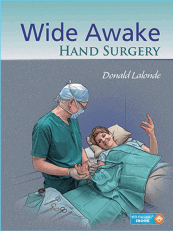Wide Awake Hand Surgery
Article information

“Wide Awake Hand Surgery” is a small illustrated technical book written by Donald Lalonde, who is a professor at Dalhousie Medical School in New Brunswick, Canada.
Dr. Lalonde has extensive expertise in hand surgery, with many years of experience using local anesthetics with epinephrine in surgery.
This book is written in a simple, easy-to-understand manner; as the author states in the preface, it has recipes similar to those of a cook-book. The abundant illustrations and descriptions provide a sufficient general understanding of how to conduct anesthesia for hand surgery. The book buyer can register and can obtain an e-book and many video clips online. Each video clip includes procedures and communications between patients and Dr. Lalonde. Communication skills are also very useful for beginning hand surgeons.
Epinephrine was discovered by Napoleon Cybulski in 1895, and was first used for ophthalmic surgery. So far, it has been believed that epinephrine should be avoided because of necrosis caused by vasoconstriction.
It is logical expectation, but it has not been supported by practical evidence. Dr. Lalonde claimed that pervious expectations is wrong. He has investigated many previous reports on the use of epinephrine as a local anesthetic in hand surgery, and ultimately came to the following conclusion about its safety: Epinephrine does not lead to necrotic changes, and is beneficial for hand surgery because it provides a bloodless field without a tourniquet. Chapters 2 and 3 contain the supporting data and evidence for this proposal. Thus, evidence-based medicine can help put our practice on solid foundations.
This book describes how to use epinephrine for hand surgery and what to expect when it is used. Most of the chapters are written well, with defined objectives and clearly presented illustrations, allowing the reader to obtain the maximum benefit in a minimal amount of time.
Another advantage of his technique is that the patient is awakened during surgery. This is unfamiliar for some surgeons, so Dr. Lalonde provides a thorough explanation of patient awakening in hand surgery.
I would like to recommend this book for hand surgeons who want to perform surgery more simply and easily.
Notes
No potential conflict of interest relevant to this article was reported.